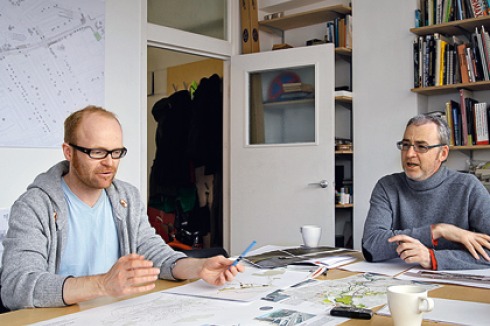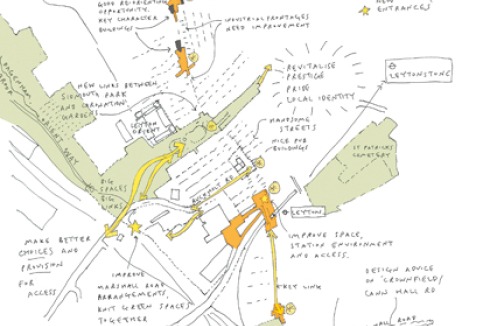Stitching and mending
London 2012
Text: Meyer, Friederike, Berlin
-

Dann Jessen, Julian Lewis
Foto: Torsten Seidel
Dann Jessen, Julian Lewis
Foto: Torsten Seidel
-

East Architecture and Landscape has been developing ideas for Design for London at Leyton to the north-east of the Olympic complex. Julian Lewis and Dann Jessen explain what they understand by “stitching”, why they want to upgrade the shopfronts and what distinguishes London from other high-density cities.
What is so interesting in Leyton?
Julian Lewis | We are engaged in Leyton, partly because of the Olympic events taking place in the area. The Borough of Waltham Forest needs to build stronger relationships to the Olympic site. But it would be too simple to say we are improving the streets and paths and building bridges just so that the ties can work.
Dann Jessen | Leyton used to be the ‘other side’ of the city. Entangled within railway lines and fences it had allotments, carwashes and out of town uses, mixed in with large swathes of housing and local high streets. Soon it will be a front entrance. But people living there still feel marginalised in the context of the Olympics. Our work in Leyton aims to make the most of the Olympics in terms of long term improvements, sometimes modest in scale but with a wide ranging urban ambition, that will take us beyond 2012.
For example?
JL | We like to work with what is already there. For example the Victorian Coronation Gardens is lovely, but hidden. To strengthen the presence and access of the Gardens we have installed street lights and widened the path to the park. We are also making new entrances into the Cricket Ground, with a sign that is also a seat with a stainless steel cricket bat as a handle. And we are improving the shop fronts on the High Road. We like to make the people aware of the so called dirty corners. For example we are putting new stairs and ramps to connect with the large sunken car park adjacent to the supermarket nearby. The message: hey, this is actually a good part of Leyton, and a way through to the Olympic sites.
Do you think seating possibilities and signs can really transform a part of a city or is it rather the result of the budget constraints?
JL | Sometimes modest adjustments can make substantial improvements. There is a market in Wood Street that hasn’t really been used in ten years. We put into place a six month program putting new shops in the mall. That may sound banal but after a short time people started applying for a stall. Some of the applicants come from Shoreditch and opened fancy restaurants.
DJ | Unpacking the local stories at Wood Street we worked with artists to remake a ‘lost film’, a silent movie which was made in one of the film studies that used to be there, but which is now lost. The artists worked with local children making the film, and when we later showed it on a spatially generous street corner the kids brought along their parents also. Together we experienced that the opportunities within the public realm are rich and that it only takes little to expand the boundaries of how it can be used.
Focusing the center of Leyton do you actually turn your back to the Olympic park?
DJ | It depends on which way you look. There’s enough focus on getting the Olympic Park to work. I think it is much more interesting what the Olympics can do for the neighbouring areas, and that there is a draw in both directions.
JL | It will be a great Olympic park. But seriously: the surrounding areas are just as great. Making these qualities visible - that’s urban planning.
Urban planning, made from stitching?
JL | Stitching means to attend to the situations on both sides. Right now there is a huge imbalance.
DJ | The legacy of the Olympics require not only thinking about how to use the Olympic sites after the games. It is therefore possibly even more, or equally important at least, for the improvements of the bordering areas to happen at the same time as the development of the Olympic Park. The dialogue between both is the stitching. It is not all about bridges and paths, rather we need reasons that someone would want to use the them as part of their everyday life.
You are planning improvements of the shop fronts on the High Streets; one that could suggest a Potemkin village.
JL | One shouldn’t forget that well designed shops have economic impact; they bring money into the neighbourhood. That strengthens the community, helps traders feel responsible and aware, and helps keep the place independent for businesses and artists who will do their work here. It is an approach that attempts to hold on the shop keepers that benefit the place, instead of just waiting for one after the other moves out as rents rise. There is a design responsibility as part of the architects’ role in this, and there is an interesting question as to how far each project is challenging a situation or simply going around it.
DJ | In Shoreditch the residential community radically changed in 15 years. First came the artists; and the relatively poor existing community was to some extent pushed out. Now the artist are slowly going and a world of investment and IT is moving in. Having empowered the people who lived there before the area got all this attention would surely have been stimulating for the way the area were going to evolve.
How does it work?
JL | We aren’t just putting new facades on shops; rather we consult with the owners to develop the design brief. This helps them to feel that their shop front, and to some extent what happens on the High Street, is their business. In strengthening quality, engagement and confidence, it may even be possible for them to feel that things are not only going to change radically behind the fences of the Olympic sites, but on the High Street too; big things they can be proud of.
This “as–found” principle was developed by the Smithsons and is once more gaining favor. Could you comment on that?
DJ | It is particularly British, the idea of working with places as they are, adjusting and adding, rather than erasing and starting afresh. And it has become a way of working within a London urbanism, for cultural, political as well as economic reasons. During the last 15 years we have learnt to find things...
JL | Actually, first of all you have to find the things. What is to be found is not a fact; it is a creative activity. You have to take a lot of effort to find and think about what a place needs. We are often considering the context at a variety of scales, including the detailed: looking at original doors and frames, stucco detailing, and window proportions. How would you otherwise differentiate London from other dense cities worldwide?
DJ | London is strangely dense and non-dense at the same time. There are all these exaggerated boundaries between estates, plots and compounds. Paris is dense, but the relationship bet-ween streets and buildings is clear. London is mostly an unusual mix of varied blocks with slack gaps and cracks between them.
Is the job of the urbanists finding this non-density, unused spaces and considering what this space could be used for?
JL | There is a big pressure on public space. Markets, restaurants and kiosks flourish in popular places such as Whitecross Market near us but there is nowhere to sit down. That’s crazy. We have to make use of the public spaces. Everybody wants a cleaned-up city, in which it is possible to move around comfortably, without fences, gates and so forth. But it’s not so easy. In London there is often a resistance to becoming a ‘dense’ city. It’s not like anyone says okay, let’s just plan it densely and enjoy it all together. Everyone is trying to safeguard their space with a boundary or buffer. And if someone pushes up against their boundary they retreat or push back.
Is there any solution?
JL | You need a lot of civilized discussion and also money, to open the city. To make it shared or shareable. I think this is not simply spatially and physically resolved, but there are also political and organizational challenges. People need to feel responsible for their spaces.
DJ | It will become better. On one hand it has got to do with overarching improvements providing a new focus, such as the GLA and Design for London, on the other it is about the many small scale interventions across the city that show that careful adjustments to urban situations can bring about large scale qualitative change.
What do you think about the overall impact of the games in London?
JL | I hope the visitors are happy with London, but not just here in the east. They will experience congested streets, weird places and they will hopefully enjoy the generous madness of London.
DJ | Perhaps the games will just simply happen. It’s only an event. But after this East London will be seen with new eyes.
x
Bauwelt Newsletter
Immer freitags erscheint der Bauwelt-Newsletter mit dem Wichtigsten der Woche: Lesen Sie, worum es in der neuen Ausgabe geht. Außerdem:
- » aktuelle Stellenangebote
- » exklusive Online-Beiträge, Interviews und Bildstrecken
- » Wettbewerbsauslobungen
- » Termine
- » Der Newsletter ist selbstverständlich kostenlos und jederzeit wieder kündbar.
Beispiele, Hinweise: Datenschutz, Analyse, Widerruf
0 Kommentare